Species
Masterlist Traits Kirunhound
Basic biology:
Kirunhounds are a large omnivorous mammalian creature artificially held in the current modern world’s biology by past Scientists. Size ranges from a very large dog (Great Dane or Wolfhound) up to a mid sized horse (Just shy of a Clydesdale.) Males are slightly larger than females and tend to have larger horns and thicker, more extensive scales.
They are highly sapient creatures capable of understanding human speech, even if they can not form human speech directly. In the wild Kirunhound live naturally in small herds containing a few breeding adults and their offspring. Once mature, young will break off to form their own groups but maintain contact with their birth herds. Extended families are very social even if not living directly with each other. Kirunhounds living alongside modernized society will live solo or in pairs that may be breeding couples, or close friends, as they tend to enjoy the company of other Kirunhounds.
Communication is a series of barks, bellows and cat like chirps. Tails are also used to further express emotions at a distance.
Kirunhound diet is varied, but leans toward intake of fresh meat from smaller prey like rabbits and fish, with herds hunting larger prey from time to time. Plant matter is also eaten readily between hunting, as well as roots, fruits and flowers.
Kirunhounds are known to live well into the early 100’s, and reach maturity around 20.
History:
There are almost no surviving records of what a Kirunhound originally looked like, or really any solid proof they existed at all before rogue science was tasked with keeping the worlds animal life breeding during a worldwide crisis. What few records survived the downfall, show that Kirunhounds were highly limited even when lab bred. Drakes and other native horned beasts like deer and goats were added artificially to early generations to extend the extremely limited breeding pool.
Traits that are based on a character’s ingame genotype:
Head and Ears:
Heads should be balanced to the body form, and should retain a feeling of canine, feline and cervine in varying levels in design. Ears follow the same base animal guideline, ranging from more canine, ursine, and feline to more equine, cervine, or bovine.

Teeth:
There are no guidelines to the size, number and prominence of a Kirunhound’s teeth.

Eyes:
Kirunhound eyes will always be a solid color, with white sclera when present. Pupils can be slit, solid, or shaped. Eyes can be any color but solid black. Heterochromia is allowed.

Front Legs:
Powerful, well padded mammalian paws that will be larger than the back legs. Fur can be smooth or contain any level of long fur tufts. Claws can range between prominent and curved, nonexistent or retractable. Number of toes and presence of a dew claw is open to player choice. Paw pads and claws can be any color.

Back Legs:
Delicate, but built for heavy running. Fur on back legs should accent, but not completely obscure the streamlined form. Hooves may be fully rounded, or cloven. Hoof points may be present on both the inner and outer side of the hoof. Hooves can be any color.

Manes and Tail Hair:
Kirunhound manes are not always present, when a mane is present it will take on any style and formation, ranging from horse like, to big cat like. Tails can feature long flowing hair like a horse, or a stiff bristle like a dog. Tail and mane fur will be the same solid color.
Masterlist Traits Popokee
Basic biology:
Popokee are highly intelligent, gregarious creatures that have old world water dwelling mammalian traits. Size ranges from average cat up to elephant depending on location and family line. There is no Sexual dimorphism in this species, males, females and rebis will all have the same external physical traits.
While not completely capable of human speech, Popokee are able to mimic some human words on a limited basis. Popokee are highly sapient, understand common language and interact with other species readily.
They live in social pods of twenty or more individuals, mixing direct family and outsiders into one large family group in the wild. Pods do not shift out mature young, instead allow them to stay as part of the family group as long as they wish, individuals that leave do so on their own whims. Popokee are relatively new to human based cities, still preferring to drift into wild spaces. Those that have settled in major cities stick with a few other Popokee either by family line, or as very closely bounded friends.
Popokee communication is very nuanced clicks, chirps and groans. Touching faces together is part of their deep social bonds, which extended even more interpersonal dialogue.
Popokee eat a mixed diet, consuming anything from local plants, shrimp, shellfish, fish, shore birds and their eggs. In city based life, Popokee have a special love for cooked rice and simple sweetened desserts. Only ‘Slowfin’ Popokee variations will eat purely plankton and cooked vegetable diets.
Popokee will live to about 80, which some family pods boasting 100+ kin. Maturity is reached at 10-12.
History:
Popokee have likely survived since before the fall, records of helpful ocean dwelling creatures touched with organic life have been recovered on prefall artifacts, leading to belief these are old world species. Popokee themselves do not keep very detailed or accurate past records, so it’s hard to collaborate details between cultures.
What little is kept from Popokee culture speaks of massive ancestral pods that once lived off the eastern coasts of the Azorian continent. Small islands in that area, uncharted by human hands are where their breed started.
Traits that are based on a character’s ingame genotype:
Plants:
Plants are a huge part of a Popokee’s personal design, these are gained just after birth, based on seeds they grow up near. Size does not need to correlate to the Popokee, a tiny wildflower can be massive, and a tree can be miniature. Plants must be naturally colored, fully black or prismatic designs will need to have the correct Magic Type Traits to pass approval.
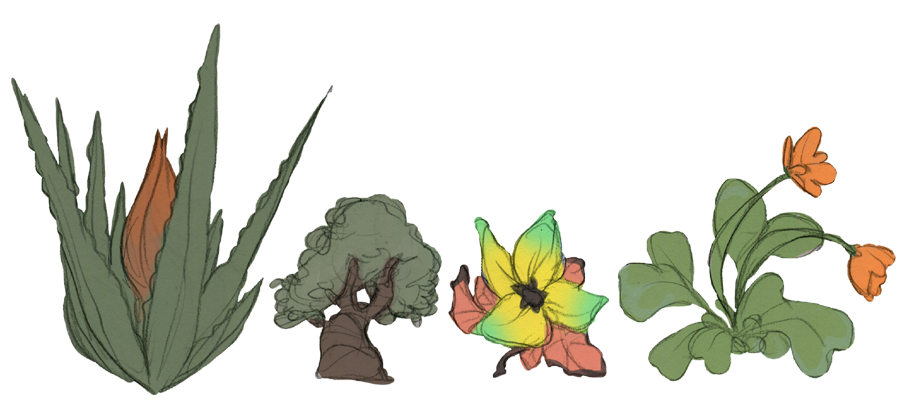
Plants may cover any earthly species of shrub, tree, grass, flower, weed, succulent, other et cetera floral lifeforms. Plants can even be completely made up within these guidelines:
-
- Plants can not have animal traits, so no paws, tails, teeth, eyes or fur/scales/feathers.
- Plants must follow gravity, so no floating, or bisected designs.
- Plants must must not glow, sparkle, or include other rare traits not covered by earthly species.
- If you are unsure about your plant design when submitting a Popokee? Please link references to your plant inspirations!
Eyes:
Popokee eyes will be rounded, with very little white sclera. Pupils can be round, slightly oblong, or missing. Popokee eye color should be natural and muted, ranging from warm browns to icy grays. Eyes can also be a solid black, and Heterochromia is allowed.


Feet:
All four feet of Popokee are lightly hooved, these can range from a single hoof, with flexible fleshy backside, to fingered toe points with a solid middle hoof, and cloven hooves with points. Many Popokee have a thumb like hoof point, allowing them to handle objects.
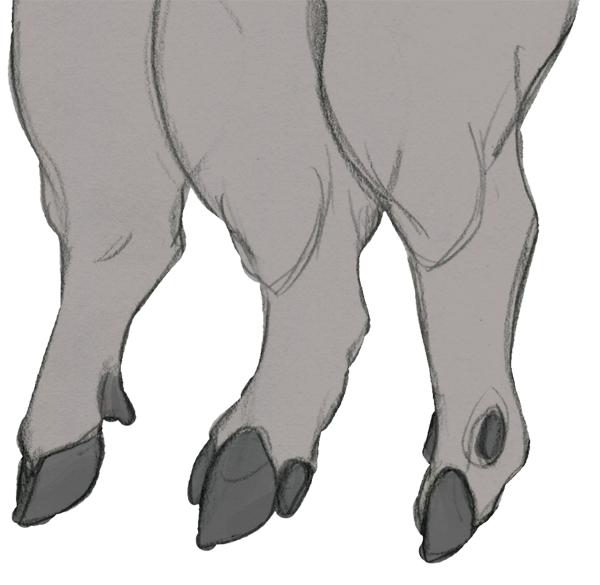
Hoof colors are dull and muted, mostly brown, grey, and tan.

Body Type:
Popokee have varied body types, ranging from more stocky pudge to thin streamlined forms. As long as their legs are compact and balanced compared to their body, their original landscape will shape the rest of their forms. Slow moving pods that live in warmer warm waters might have manatee like builds, while agile hunters that take down large fish off colder coasts will have narrow bodies with longer legs. This is up to designers, take the local homelands and build from there.

Personal Symbol:
Along with being born with attached plants, Popokee are also born with a personal symbol tied to their inherently magical nature. These symbols can be anything from shapes, to letters, or abstract designs. While not visible at birth, they earn physical form as the Popokee ages, showing up as small floating aether marks in the air. Once physical, personal Symbols can appear near any part of a Popokee’s body, from over the head or tail, in front of the chest or along a leg or side. Personal symbols will always be a single solid color except black.

Masterlist Traits Balikin
Basic biology:
We are large creatures in-between avian, reptile and mammal. We can fly. We’re all about 5 feet tall, but can range a little smaller or larger up to 8 feet for some big hybrids between regions. Female presenting Balikin have duller colors and smaller feathers, while male presenting Balikin have bright, exaggerated feathers. Otherwise all genders are generally similar in build and presentation.
We live in family groups not related by blood, and these groups are around 7-12 Balikin, we are very sociable and will take in others in need, we also share resources between different family groups.
Balikin can speak Human and Kirunhound. But our speaking voices are different than yours, so we sound a bit different when using your languages. Talking to each other we use body language and clicks, growls and beeps.
We eat all things, if we eat meat we try to only eat small things like bugs, frogs and eggs. We love fruit!
I don’t know how you count time, but we live a long time I think.
~Sootrot
History:
We lived here forever, you people are the new ones.
Traits that are based on a character’s ingame genotype:
Body Type:
--Eyes:
Balikin eyes are built for long distance views, and will always be round or oval. Pupils will also be round or oval and always present. If a sclera is present it will only be white, black, red or yellow. Eye color can be any color including pure black or white. Heterochromia is not present.
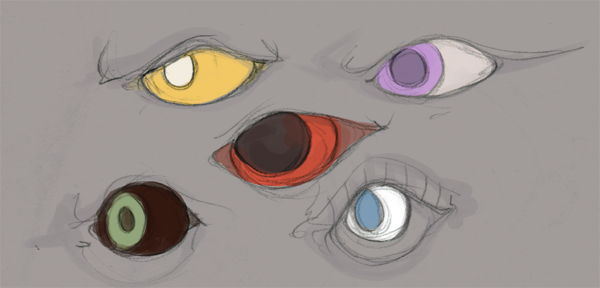
Feet:
Balikin feet are highly variable and are not shaped by their heritage. The feet will be bird like, with some reptile traits that might be present. Balikin will have between 2 and 5 toes per foot, each with a sharp clawed toe. Feet can have dense scales, fluffy feathering or a light furring. Feet, scales, and claws can be any color, but should look to earthly birds and reptiles for guidelines.
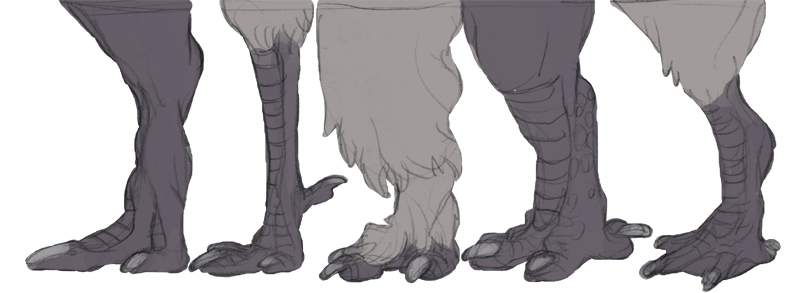
While Balikin feet don’t follow any regional heritage, the shape of their feet will dictate how they live, a Balikin that runs across open ares will benefit from 2 large toes, while a 4 toed foot split front and back might be better for a Balikin that lives in trees hunting in the dark.
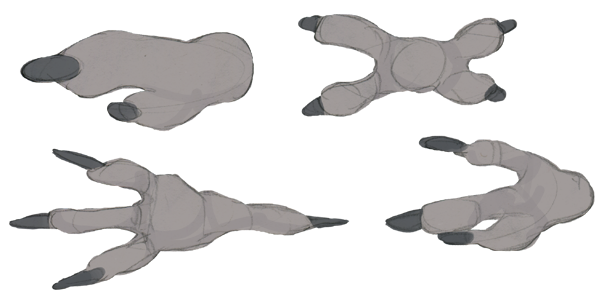
Teeth and Mouth:
Balikin have many small sharp teeth that don’t extend far from the mouth, canine teeth might be slightly larger and hang over the lip. Tongues can be large and flat, or sharp and narrow. Tongues can also be splayed or split at the tip. Teeth can be black or white. Tongues will be pinks, tans, purples or dull off white.


Masterlist Traits Familiar
Alongside the intelligent species of the world that players will focus on leveling, breeding and interacting with, familiars act as small, more feral creatures that provide players unique boosts. Each familiar type has a set skill, which is also affected by their elemental type.
Familiars will never have genetic traits, be breedable, or earn titles in game, instead each is uniquely drawn and collectable. Familiars may be traded, sold and auctioned within the game.
Types of known Familiars:
Yens - Oraborhys - Changlings - Klingka